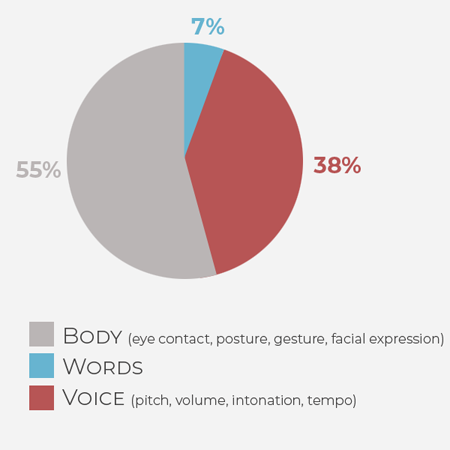33 Public Speaking
Qing Mao
Public speaking means connecting with a live audience, establishing a relationship with them, and hopefully changing their perspective on an issue or topic through the power of your voice.
What You’ll Learn:
- Why public speaking is important
- Why master the art of verbal communication
- What role non-verbal communication plays
- How to speak with your own style
If you’re afraid of public speaking, you’re not alone. According to John Montopoli (2017), a therapist at the National Social Anxiety Center, “The fear of public speaking is the most common phobia ahead of death, spiders, or heights. The National Institute of Mental Health reports that public speaking anxiety, or glossophobia, affects about 73% of the population.”
So how do you overcome a fear of public speaking? You can ask yourself: What is it that I’m afraid of? Then you can do something to overcome that fear. Look at the following factors that can make you nervous giving a speech.
You can learn more about why many of us are afraid of public speaking here.
And you can gather some useful ideas about how to conquer your fear here.
Why Public Speaking Is Important
Public speaking is a powerful way of sending information, spreading ideas, making connections, influencing decisions, and promoting changes (“3 Reasons Why Public Speaking Is Important,” 2014). Unlike writing, speaking more directly wakens people’s senses by employing not only words but also voice and body language.
These are the major reasons why public speaking is an essential skill.
To give information
Giving information in a logical and clear manner is one of the most important skills across all work fields. From giving presentations in school to presenting ideas to your boss or colleagues, you need the ability to make your audience remember your words and enhance their understanding on your subject.
To send a message
During public speaking, you’re engaged with a dynamic interaction with the audience. You can use your voice and body language to help drive home the core message. Whether in product promotion or political debate, mastering public speaking helps boost confidence and advocate ideas in a more efficient way.
To motivate change
A great public speaker has the potential to motivate the audience to make positive changes and reach goals. During public speaking, you convey your passion to the audience more directly. Unlike a writer, a public speaker can make emotional connections through auditory and visual channels.
Listen to this source to learn about the greatest speakers in history.
What information do you get from the talk? What message do you get? Do you feel motivated to become a successful public speaker after listening to the talk?
Why Master the Art of Verbal Communication

What’s verbal communication?
Verbal communication is either spoken or written communication. It is the most direct way to share your ideas and experience with others.
During verbal communication, you choose words to send messages. Carefully chosen words can help you send a message effectively, and should fit the context, whether more casual or more formal.
Also, remember that verbal communication is a two-way interaction—it’s easy to miss, but the listener is just as important as the speaker.
Use simple words and short sentences to ensure effective communication
Words used in a public speech should be simple and accurate, and as free as possible of jargon, technical terms, and other long or unfamiliar words.
Sentences should be concise and vigorous. Short simple sentences are more effective in helping send a clear message.
The following is the opening of the commencement address delivered on May 25, 2017, at Harvard University by Mark Zuckerberg, Facebook CEO, who dropped out to pursue his own dream.
“President Faust, Board of Overseers, faculty, alumni, friends, proud parents, members of the ad board, and graduates of the greatest university in the world. I’m honored to be with you today because, let’s face it, you accomplished something I never could. If I get through this speech, it’ll be the first time I actually finish something at Harvard. Class of 2017, congratulations!” (The Harvard Gazette, 2017).
You can listen to Mark Zuckerberg’s full speech here.
Role of Non-verbal Communication
What’s non-verbal communication?
Non-verbal communication is any system of communication that doesn’t use language. It includes gestures, posture, facial expressions, tone of voice, eye contact, and other ways people convey ideas without using language.
Think, for example, of what a smile communicates—or a frown.
Non-verbal communication skills are essential. When you give a public speech, you should avoid behaviours such as monotone delivery, fidgeting, lack of eye contact, poor posture, or overuse of gestures.
Use tone of voice and body language to create impact
Tone of voice and body language have audio and visual impacts on the audience. They can demonstrate a speaker’s personality, attitude, and emotion.
| TONE OF VOICE | BODY LANGUAGE | |
|---|---|---|
| Definition | Tone of voice is the pitch, intonation, volume, and tempo of your voice. It can be used to change the meaning of your words. A public speaker uses tone of voice to emphasize certain information and to inspire and empower the audience. | Body language can be more truthful than words. Body language uses physical actions or behaviours to convey meaning. Arching an eyebrow, squinting, frowning, crossed arms and legs, and steepling fingers can reveal a speaker’s emotions. |
| Example | A deep voice tends to convince an audience. Raising voice pitch can draw an audience’s attention. Tone of voice can also be used to soothe or excite an audience. For example, salespeople may use an upbeat tone to try to get their audience excited to buy products. Doctors often use a soothing tone to put patients at ease. | Using positive body language can help you promote your idea, ace a job interview, start a relationship, and win an argument. Negative body language can make you lose opportunities at work, offend people you want to impress, or lose a friendship. For example, making good eye contact and sitting with a relaxed posture during a conversation can bring you trust from friends, while fidgeting and rubbing your nose can cause your friends to lose interest in the conversation. |
| Extra Information | Learn more about tone of voice here. | Learn more about how body language can help us to transmit information. |
Did You Know?
“An estimated 60 to 65 percent of interpersonal communication is conveyed via nonverbal behaviours” (Foley & Gentile, 2010).
Have you heard of the 7-38-55 rule of personal communication? The rule, which was developed by Albert Mehrabian, Professor Emeritus of Psychology at the University of California, suggests that spoken words only communicate seven percent of meaning. Thirty-eight percent of communication is achieved through voice, and 55 percent through body language (MasterClass, 2020).

Speak with Your Style

History boasts many master speakers. For example, Mahatma Gandhi, who called for a passive but determined resistance against England’s rule of India in his “Quit India” speech, and Barack Obama, whose victory address to crowds in Chicago after his historic election is regarded as one of the most powerful speeches in modern politics. What makes them powerful speakers?You can hear the speech that made Obama president here.
Speakers have unique ways to deliver their message to the audience. Directed by your purpose, you can develop your own style of public speaking. The key is to gracefully deliver a speech with confidence and charisma. The goal is to catch your audience’s attention and drive home your message.
You can learn more about speaking styles here.
Watch this source for a TED Talk given by Celeste Headlee, an award-winning journalist, author, and accomplished speaker, on how to have a better conversation.
What makes her stand out as a powerful speaker? What is her speaking style?
Try it!
You learned why public speaking is important, and the role of both verbal and non-verbal communication in public speaking. You also learned qualities of language (concise, accessible speech) and voice (style and tone) that help make speeches powerful and effective.
References
See Public Speaking References
Terms specific to a discipline, profession, or other group. Often difficult for outsiders to understand.
Communicating your full meaning in the fewest possible words.
How high or low you speak relative to your range.
Personal magnetism, a quality that attracts others to you.


In the opening of his speech, Zuckerberg uses simple words, short sentences, and humour to build a connection with the audience.